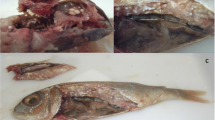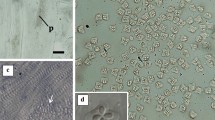Abstract
Background
Digenean trematodes of the family Didymozoidae are tissue parasites that are particularly common in scombrid fish. These parasites can reduce the commercial value of fish, especially the ones occurring in the muscle.
Purpose
In the present study and for the first time, we report the occurrence of didymozoids in muscle tissue of Atlantic chub mackerel (Scomber colias) collected in northeast Atlantic (Portuguese coast).
Methods
The entire musculature of 64 Scomber colias was removed and examined macroscopically and under a stereomicroscope to search for parasites.
Results
The prevalence (3.1%) and abundance (0.03) of infection detected were quite low, but the parasites cause muscle softening decreasing the quality of the infected fish. If the infection levels increase, this may constitute a cause of concern for the fisheries and canning industry.
Conclusion
Didymozoids identified in this study are closely related to muscle parasites detected in other fish species of the genus Scomber, most probably the same species. Phylogenetic analysis also corroborates the hypothesis that muscle-parasitizing didymozoids are distinct from the ones parasitizing other fish organs.




Similar content being viewed by others
References
Abe N, Okamoto M (2015) Molecular characterization of muscle-parasitizing Didymozoid from a chub mackerel, Scomber japonicus. Acta Parasitol 60:557–562. https://doi.org/10.1515/ap-2015-0080
Abe N, Okamoto M, Maehara T (2014) Molecular characterization of muscle-parasitizing Didymozoids in marine fishes. Acta Parasitol 59:354–358. https://doi.org/10.2478/s11686-014-0234-2
Alves DR, Luque JL (2006) Ecologia das comunidades de metazoários parasitos de cinco espécies de escombrídeos (Perciformes: Scombridae) do litoral do estado do Rio de Janeiro, Brasil. Revista Brasileira de Parasitologia Veterinária 15:167–181
Block BA, Stevens ED (eds) (2001) Tuna: physiology, ecology, and evolution, vol 19, 1st edn. Gulf Professional Publishing, Oxford, p 468
Brito A, Ramos V, Mota R, Lima S, Santos A, Vieira J et al (2017) Description of new genera and species of marine cyanobacteria from the Portuguese Atlantic coast. Mol Phylogenet Evol 111:18–34. https://doi.org/10.1016/j.ympev.2017.03.006
Bush AO, Lafferty KD, Lotz JM, Shostak AW et al (1997) Parasitology meets ecology on its own terms: Margolis et al. revised. J Parasitol 83:575–583. https://doi.org/10.2307/3284227
Cabral HN, Murta AG (2002) The diet of blue whiting, hake, horse mackerel and mackerel off Portugal. J Appl Ichthyol 18:14–23
Chero J, Cruces C, Iannacone J, Sáez G, Sanchez L, Minaya D et al (2015) First record of Unitubulotestis pelamydis (Trematoda: Didymozoidae) and Sphyriocephalus tergestinus (Cestoda: Sphyriocephalidae) in eastern pacific bonito, Sarda chiliensis (Perciformes: Scombridae) in Peru. Neotrop Helminthol 9:313–323
Collette B, Nauen C (1983) Scombrids of the world An annotated and illustrated catalogue of tunas, mackerels, bonitos and related species known to date. FAO Fish Synop 125:137
Costa G, Cavallero S, D’amelio S, Paggi L, Garcia Santamaria MT, Borges Perera C et al (2011) Helminth parasites of the Atlantic chub mackerel, Scomber colias Gmelin, 1789 from Canary Islands, Central North Atlantic, with comments on their relations with other Atlantic regions. Acta Parasitol 56:98–104. https://doi.org/10.2478/s11686-011-0006-1
Cremonte F, Sardella NH (1997) The parasito Fauna of Scomber japonicus Houttuyn, 1782 (Pisces: Scombridae) in two zones of the Argentine Sea. Fish Res 31:1–9
Cruces C, Chero J, Iannacone J, Diestro A, Sáez G, Alvariño L (2014) Metazoans parasites of “chub mackerel” Scomber japonicus Houttuyn, 1782 (Perciformes: Scombridae) at the Port of Chicama, La Libertad, Peru. Neotrop Helminthol 8:357–381
Darriba D, Taboada GL, Doallo R, Posada D (2012) JModelTest 2: more models, new heuristics and parallel computing. Nat Methods 9:772
Edgar RC (2004) MUSCLE: multiple sequence alignment with high accuracy and high throughput. Nucleic Acids Res 32:1792–1797. https://doi.org/10.1093/nar/gkh340
Eiras JC, Rego AA (1987) The histopathology of Scomber japonicus infection by Nematobothrium scombri (Trematoda: Didymozoidae) and of larval anisakid nematode infections in the liver of Pagrus pagrus. Memórias do Instituto Oswaldo Cruz 82:155–159
Galaktionov KV, Dobrovolskij A (2013) The biology and evolution of trematodes: an essay on the biology, morphology, life cycles, transmissions, and evolution of digenetic trematodes. Springer, Berlin
Gibson DI, Mackenzie K, Cottle J (1981) Halvorsenius exilis gen. et sp. nov., a new Didymozoid trematode from the mackerel Scomber scombrus L. J Nat Hist 15:917–929. https://doi.org/10.1080/00222938100770681
Guindon S, Gascuel O (2003) A simple, fast and accurate method to estimate large phylogenies by maximum-likelihood. Syst Biol 52:696–704. https://doi.org/10.1080/10635150390235520
Hermida M, Cavaleiro B, Gouveia L, Saraiva A (2018) Parasites of skipjack, Katsuwonus pelamis, from Madeira, Eastern Atlantic. Parasitol Res 117:1025–1033. https://doi.org/10.1007/s00436-018-5778-x
Justo MCN, Kohn A (2005) Didymozoidae (Digenea) parasites of Scombridae (Actinopterygii) from Rio de Janeiro coast, Brazil. Revista Brasileira de Zoociências 7:333–338
Justo MCN, Kohn A (2012) A new genus and species of the Didymozoidae (Digenea) from the skipjack tuna Katsuwonus pelamis (L.) (Scombridae). Syst Parasitol 81:195–201. https://doi.org/10.1007/s11230-011-9340-9
Justo MCN, Kohn A, Pereira CD, Flores-Lopes F (2013) Histopathology and autoecology of Didymocylindrus simplex (Digenea: Didymozoidae), parasite of Katsuwonus pelamis (Scombridae) in the Southwestern Atlantic Ocean, off South America. Zoologia 30:312–316. https://doi.org/10.1590/S1984-46702013000300008
Justo MCN, Kohn A (2015) Diversity of Monogenoidea parasitizing scombrid fishes from Rio de Janeiro coast, Brazil. Check List 11:1628. https://doi.org/10.15560/11.3.1628
Kamegai S, Araki J (1995) A new digenean, Didymocystis margolisi n.sp. (Didymozoidae: Didymozoinae), from the skipjack tuna, Katsuwonus pelamis, of Japan. Can J Fish Aquat Sci 52:95–97
Kohn A, Justo MCN (2008) Didymocystis lamotheargumedoi n. sp. (Digenea: Didymozoidae) a parasite of three species of scombrid fishes. Revista Mexicana de Biodiversidad 79:9S–14S
Lester R, Barnes A, Habib G (1985) Parasites of skipjack tuna, Katsuwonus pelamis: fishery implications. Fish Bull 83:343–356
Madhavi R (1982) Didymozoid trematodes (including new genera and species) from marine fishes of the Waltair coast, Bay of Bengal. Syst Parasitol 4:99–124
Madhavi R, Ram BS (2000) Community structure of helminth parasites of the tuna, Euthynnus affinis, from the Visakhapatnam coast, Bay of Bengal. J Helminthol 74:337–342
Mele S, Merella P, Macias D, Gomez MJ, Garippa G, Alemany F (2010) Metazoan gill parasites of wild albacore Thunnus alalunga (Bonaterre, 1788) from the Balearic Sea (western Mediterranean) and their use as biological tags. Fish Res 102:305–310. https://doi.org/10.1016/j.fishres.2010.01.002
Mele S (2012) Gill metazoan parasites of tunas (Scombridae: Thunnini) from the western Mediterranean Sea: systematics, assemblages and use as biological tags. Ph.D. Thesis. Università Degli Studi Di Sassari, Scuola Di Dottorato in Riproduzione, Produzione, Benessere Animale E Sicurezza Degli Alimenti Di Origine Animale, p 157
Mele S, Macias D, Gomez-Vives MJ, Garippa G, Alemany F, Merella P (2012) Metazoan parasites on the gills of the skipjack tuna Katsuwonus pelamis (Osteichthyes: Scombridae) from the Alboran Sea (western Mediterranean Sea). Dis Aquat Org 97:219–225. https://doi.org/10.3354/dao02421
Mele S, Pennino MG, Piras MC, Bellido JM, Garippa G, Merella P (2014) Parasites of the head of Scomber colias (Osteichthyes: Scombridae) from the western Mediterranean Sea. Acta Parasitol 59:173–183. https://doi.org/10.2478/s11686-014-0207-5
Mladineo I, Bott N, Nowak B, Block B (2010) Multilocus phylogenetic analyses reveal that habitat selection drives the speciation of Didymozoidae (Digenea) parasitizing Pacific and Atlantic bluefin tunas. Parasitology 137:1013–1025. https://doi.org/10.1017/S0031182009991703
Mladineo I, Segvic T, Petric M (2011) Do captive conditions favor shedding of parasites in the reared Atlantic bluefin tuna (Thunnus thynnus)? Parasitol Int 60:25–33. https://doi.org/10.1016/j.parint.2010.09.007
Nikolaeva V (1985) Trematodes–Didymozoidae fauna, distribution and biology. In: William J, Hargis J (eds) NOAA technical report NMFS 25, pp 67–72
Oliva ME, Valdivia IM, Costa G, Freitas N, De Carvalho MAP, Sanchez L et al (2008) What can metazoan parasites reveal about the taxonomy of Scomber japonicus Houttuyn in the coast of South America and Madeira Islands? J Fish Biol 72:545–554. https://doi.org/10.1111/j.1095-8649.2007.01725.x
Pascual S, Abollo E, Azevedo C (2006) Host–parasite interaction of a muscle-infecting didymozoid in the Atlantic mackerel Scomber scombrus L. ICES J Mar Sci 63:169–175. https://doi.org/10.1016/j.icesjms.2005.08.010
Pozdnyakov SE, Gibson DI (2008) Family Didymozoidae Monticelli, 1888. In: Bray RA, Gibson DI, Jones A (eds) Keys to the Trematoda, vol 3. CAB International, Wallingford, pp 631–734
Price MN, Dehal PS, Arkin AP (2009) FastTree: computing large minimum evolution trees with profiles instead of a distance matrix. Mol Biol Evol 26:1641–1650. https://doi.org/10.1093/molbev/msp077
Price MN, Dehal PS, Arkin AP (2010) FastTree 2—approximately maximum likelihood trees for large alignments. PLoS One 5:e9490. https://doi.org/10.1371/journal.pone.0009490
Sambrook J, Russell DW (2001) Molecular cloning: a laboratory manual. Cold Spring Harbor Laboratory Press, New York
Shukhgalter OA (2004) The parasite fauna of the chub mackerel (Scombridae: Scomber japonicus Houttuyn, 1782) in the central-eastern Atlantic (Atlantic coast of Northern Africa and the Azores Archipelago banks). Parazitologiya 38:160–170
Funding
This paper was partially supports by the project INNOVMAR—Innovation and Sustainability in the Management and Exploitation of Marine Resources (reference NORTE-01-0145-FEDER-000035), supported by North Portugal Regional Operational Programme (NORTE 2020), under the PORTUGAL 2020 Partnership Agreement, through the European Regional Development Fund (ERDF).
Author information
Authors and Affiliations
Corresponding author
Additional information
Publisher's Note
Springer Nature remains neutral with regard to jurisdictional claims in published maps and institutional affiliations.
Electronic supplementary material
Below is the link to the electronic supplementary material.
Rights and permissions
About this article
Cite this article
Mota, R., Alves, M., Vieira, C.P. et al. Didymozoids in Muscle of Atlantic Chub Mackerel (Scomber colias). Acta Parasit. 64, 308–315 (2019). https://doi.org/10.2478/s11686-019-00049-5
Received:
Accepted:
Published:
Issue Date:
DOI: https://doi.org/10.2478/s11686-019-00049-5




